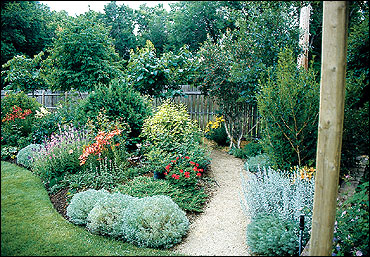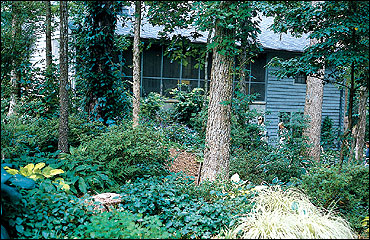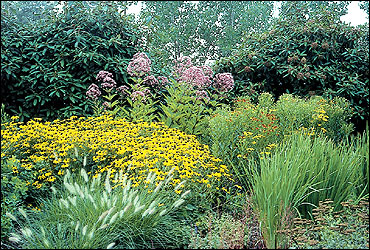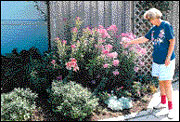Few homeowners intentionally install a landscape that requires a great deal of maintenance. However, unless care and planning are used in landscaping, you may find yourself spending more time taking care of the yard than you had hoped.
The term "low-maintenance landscaping" should be kept in perspective. All landscapes require some maintenance. Plants are living organisms that require routine care to thrive. However, with proper design and selection and timely maintenance, you can create a home landscape for leisurely enjoyment.
To achieve a satisfying landscape design, the planting process must begin with planning. Whether renovating an existing landscape or installing a new one, a good place to start is to take a family inventory. Most likely you will not immediately install all of your plan's features. Consider both your present needs and future desires in this planning stage. Set priorities and develop the plan as time and money allow.
Site analysis
Once the use areas of the property are defined, take a closer look at environmental aspects of the property. For a complete analysis, the property must be examined at various times of the year. For example, you'll want to provide some protection from winter winds but open the home to cooling summer breezes. Likewise, shade patterns change dramatically with the seasons. Provide for early morning and late afternoon shade during summer months by locating shade trees on the east and west exposures of the home. Leave the area directly south of the house open to allow winter sunlight to warm the house.
In addition to sun and wind control needs, the site analysis should include a check of soil drainage and storm runoff. Low spots may need additional fill or a change of grade to permit proper drainage. Steep slopes may need a retaining wall or terracing. Make note of special microclimates — areas that are particularly protected, exposed, dry, wet, shaded, sunny, cool, or hot. For example, the south side of the house may be protected from extreme winter temperatures and winds, but be excessively hot and dry during summer, while an area near a downspout may be constantly wet. Also note good views that should be preserved or unsightly views that should be screened.
Take a soil test to determine if soil amendments or fertilizers are needed. Most Missouri soils benefit from the addition of organic matter. Where the soil can be tilled, add 1 to 3 inches of peat, compost, or well-rotted manure to the surface of the existing soil. A 1-inch-deep layer requires about 3 cubic yards of organic material per 1,000 square yards. Work the organic matter into the top 6 inches of existing soil. Avoid tilling under established trees. Tilling destroys many tree roots, leading to possible decline or death of the tree. Improve soils under trees slowly by adding compost to core aeration holes or amending small pockets of soil within the tree's root zone each year.
Maintenance by design
Maintenance needs in the landscape are closely tied to the design. Aesthetic reasons for including certain features in the landscape may be in conflict with low-maintenance goals. A compromise may need to be made between an unimaginative landscape with least possible maintenance and a more pleasant, functional landscape with low-maintenance features. Following are some design considerations to enhance low maintenance.
- Simplicity
Simplicity is characteristic both of good design and low-maintenance landscapes. Eliminate frills such as statues and water features, or design them for easy care and maintenance. To avoid overplanting, make certain each plant in the plan serves a purpose. Allow enough space for each plant to grow to its full size without constant pruning to keep it in bounds. Use several different types of plants to create interesting textures and colors in the landscape, but avoid excessive variety that leads to a busy appearance. - Reduce size
Sweeping vistas are dramatic for public gardens, but home landscapes are more intimate if kept at a smaller scale. For large acreages, keep a small area near the home highly manicured and allow areas farther away to naturalize. Even city-sized lots may be developed with small prairie or woodland gardens. Consider how much time you have to maintain plantings. It takes little time to plant a large vegetable or flower garden, but considerably more time to keep it weeded, watered and harvested. You may receive more enjoyment from container gardens or a small plot you can adequately maintain.
 Figure 1
Figure 1
Plants grouped into beds require less care than individual specimens. Develop walkways through wide beds for easy access and maintenance.
- Plant arrangement
Scattered plants take more care than plants massed together in groups. Hand edging and trimming around individual plants is time consuming. Minor flaws on a single tree, shrub or flower may stand out, requiring immediate attention, while a similar problem in a cluster of plants may be partially hidden, permitting delayed maintenance. Beds should be narrow enough for easy access, or be designed with steppingstones or paths through them (Figure 1). If the bed is accessible from one side only, 3 feet is the suggested maximum depth. If accessible from both sides, the bed may be 4 or 5 feet wide. Group plants of similar environmental needs. It is difficult to provide proper water and light to all plants if those with dissimilar needs are mixed together.
 Figure 2
Figure 2
Many groundcovers are better adapted to shady yards than turf grasses are. Choice of plant materials ranges from big, bold-leaved hostas to grasslike liriope. In addition to providing interesting foliage colors and textures, many groundcovers bloom for several weeks each growing season.
- Turf alternatives
Turf requires more maintenance than other types of landscape plants. Flowers are also relatively high in maintenance needs, while groundcovers require slightly less care. Shrubs and trees require the least maintenance. To minimize landscape maintenance, consider reducing the area of the yard devoted to turf. Keep large enough grassy areas for entertaining needs and play areas, but convert excess turf areas into plantings with lower maintenance needs. Groundcovers are often better choices than turf for steep slopes difficult to mow or shady areas where grass does not grow well (Figure 2). - Hardscape features
Hard-surfaced areas such as patios and decks can add greatly to useable outdoor living space. At the same time, they are relatively low maintenance. If extra parking space is needed for a boat, recreational vehicle, or extra car, a paved or graveled area will be easier to maintain. Sidewalks, fences and edging around beds should be designed to minimize the amount of hand trimming necessary. Avoid sharp corners or narrow strips that mowers can't reach. Edges of hard surfaces should be low and flat, permitting a power mower to ride up over the surface and eliminating the need for hand edging. - Use mulches
Use 2 to 4 inches of mulch around plants to minimize weed growth and conserve moisture. Additional benefits from mulching include erosion control, reduced soil compaction and moderation of soil temperatures. As organic mulches such as wood chips or shredded bark break down, they add organic matter to the soil. When organic mulches are used, some additional nitrogen fertilization may be necessary to avoid nutrient deficiency in mulched plants. Mulching trees and shrubs facilitates mowing and decreases the likelihood of damage to plants from mowers or string trimmers hitting against the stem.
Plant selection and establishment
Good low-maintenance design techniques may be negated by improper plant selection. Choose the right plant for the site. Following are some pointers for selecting and establishing your landscape plants.
- Choose low-maintenance plants
Certain plants require more care than others. The ideal low-maintenance plant has a moderate growth rate, few pest problems, and produces no messy fruits, pods or shedding branches. No landscape plant is perfect. Choose those with the fewest flaws. For example, choose a crabapple with resistance to apple scab to prevent summer defoliation. Also look for varieties that hold their fruit well into winter when birds will eat them. - Select quality plants
A plant suffering from environmental stresses (overwatering, excessive drying, cold injury, etc.) or pest problems at planting time may never fully recover in the landscape. Purchase healthy, vigorous stock from reputable nursery suppliers. Check plants closely for signs of pest problems. Don't turn your landscape into an infirmary for plants.
 Figure 3
Figure 3
A combination of introduced ornamental grasses and native wildflowers backed by Viburnum shrubs makes an attractive low-maintenance border adapted to dry, sunny conditions.
- Use adapted plants
Select plants that are adapted to the growing conditions you have in your yard (Figure 3). Use sun-loving plants in exposed areas and shade-tolerant ones under trees. Also consider moisture conditions on the site. Native plants are adapted to local climate extremes and often have resistance to regional pest problems. Introduced plants native to areas with similar climates are also a good choice. Keep in mind that planting sites often bear little resemblance to native soils because of excavation and grade changes during the construction process. Plants that were growing on the site before construction may not be well adapted to the site after construction without soil amendment. - Follow good planting practices
Improper planting techniques can lead to poor establishment or even death of the plant later on. Dig planting holes shallow and wide. Trees, shrubs and other plants should be placed no deeper in the planting hole than they were in the container or planting ball in which they were previously growing. In heavy, poorly drained soils, it is preferable to plant several inches above the surrounding grade, or in extreme cases, in a raised berm.
Most new root growth will occur near the soil surface, so efforts to amend soil should be concentrated in the surface 6 inches, extending as far out from the plant as practical. Mix any soil amendments thoroughly with existing soil. Root growth and water movement in soils is impeded when sharp contrasts exist in soil texture. If only a small area can be amended, it may be preferable to avoid soil amendments altogether.
Avoid pruning woody plants at planting time. Remove only damaged shoots and roots. Wait to do extensive pruning until the plant is established.
Provide adequate water to new plantings until they are established. Typically, one or two full growing seasons are required for roots to extensively develop into surrounding soil. Check for water needs in the old root ball, not in the new planting hole.
Fertilize according to soil test indications. Avoid over-fertilizing new plantings. Fertilizers are salts that can dehydrate tender new root growth.
 Figure 4
Figure 4
Check garden plantings to detect pest problems in early stages. Look closely at stem tips and on undersides of leaves. Note development of any unusual spots or discolortation on leaves and stems.
Proper maintenance
After plants are established in the landscape, maintenance needs can be minimized by following correct maintenance procedures on a timely basis. Following are some suggestions to reduce the time and amount of maintenance necessary in established landscapes.
- Practice preventive maintenance
Be observant of your plants (Figure 4). Watch for disease and insect outbreaks regularly. Pests are much easier to control if they are affecting only a few leaves or one branch. By the time they spread to several plants or an entire shrub border, they will be more difficult to control. Get to know which pests and amount of injury are tolerable for various plants. Many homeowners are surprised to discover that a well-established deciduous tree can withstand complete defoliation with minor consequences. - Use the right tool
Power tools can make short work of many maintenance operations. However, make certain they are the right tool for the job. For example, weed whips or string trimmers quickly mow down weeds and grass around buildings and fences, but should be used with caution around trees. The force of the trimmer line can cause injury to the bark, leading to girdling, unless the tree is protected from direct contact with the trimmer. - Irrigate various plant zones separately
Some plants are better adapted to hot, dry conditions than others. If plants of similar growth requirements are grouped together in the landscape, they can be watered as a group. Use the appropriate type of irrigation system for the planting. Overhead sprinklers or pop-up heads on an underground irrigation system may be most appropriate for turf. In flower beds, spray-type emitters must be placed higher for proper water distribution. For trees, shrubs and flower beds, drip irrigation may be the most efficient system. - Fertilize in moderation
Base fertilization programs on soil test results. Recycle as many nutrients as possible on site by leaving clippings on the lawn and applying leaf mulch compost to planting beds. Over-fertilization leads to excessive growth that needs frequent pruning. Excessive fertilization may also force growth that will be more susceptible to insect and disease attack. - Prune when appropriate
Take care of pruning needs when the problem first develops. Cut out weak, narrow crotches on branches, crossing branches or competing branches while they are still small in diameter. These problems will not correct themselves, and the pruning job becomes more major with each season the task is delayed. Avoid planting trees and shrubs where they will outgrow their allotted space without frequent pruning. Use the appropriate pruning tool for the job. By-pass or scissor-cut hand pruners and loppers make cleaner cuts than do anvil types. Pruning saws should be used for large cuts.
Several hours of planning and thought before planting can prevent maintenance headaches for years to come.